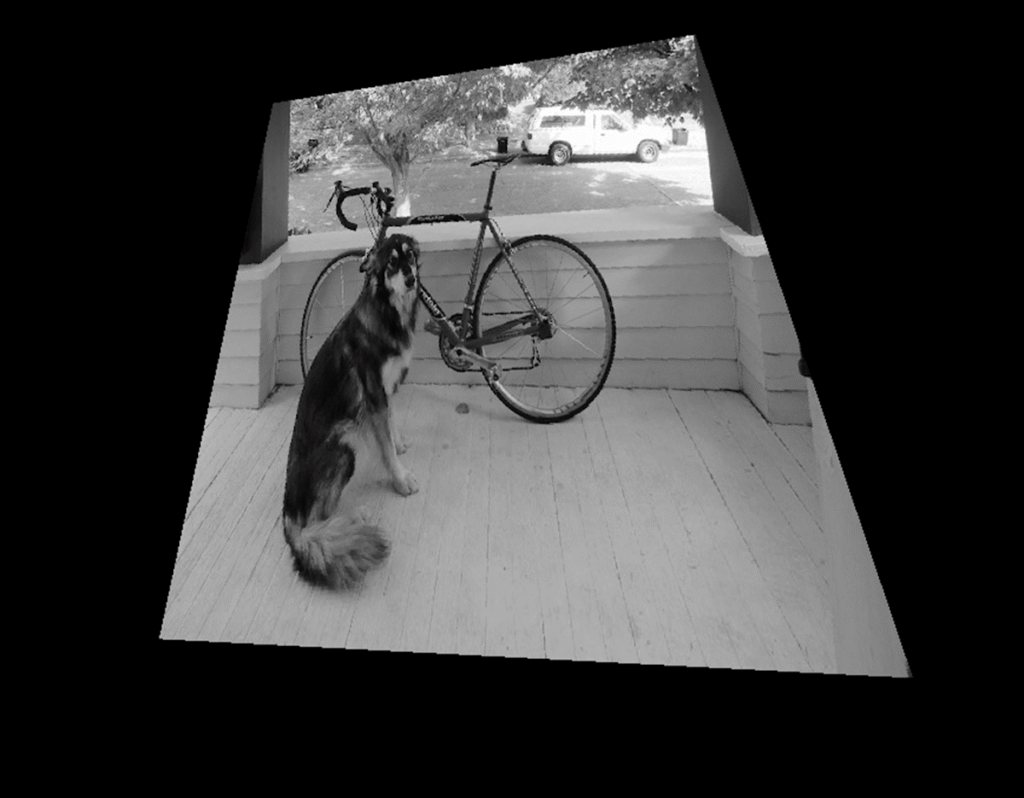MATLAB、Python、Scilab、Julia比較ページはこちら
https://www.simulationroom999.com/blog/comparison-of-matlab-python-scilab/
はじめに
の、
MATLAB,Python,Scilab,Julia比較 第3章 その106【射影変換(台形→長方形)④】
を書き直したもの。
射影変換の話の続き。
台形の画像を長方形にする。
今回はPython(NumPy)でこれを実現する。
【再掲】変換元、変換先パラメータ
まずは、変換元、変換先パラメータを再掲。
\(
\begin{eqnarray}
(-0.5,-0.8)→&(-1,-1)\\
(-0.8,0.8)→&(-1,1)\\
(1,1)→&(1,1)\\
(0.4,-1)→&(1,-1)\\
\end{eqnarray}
\)
今回は、このパラメータによる射影変換をPython(NumPy)で実現する。
Pythonコード
Pythonコードは以下になる。
import numpy as np
import cv2
# アフィン変換関数
def homograpy(img, matrix):
# 画像サイズ取得
hight, width = img.shape
# 中心を0とした座標系を生成
x_axis = np.linspace(-1, 1, width);
y_axis = np.linspace(-1, 1, hight);
xim,yim = np.meshgrid(x_axis, y_axis);
# 座標x,y,1の3次元ベクトルの配列
# reshapeで行ベクトル化、「*」で式展開
points=np.array([[*xim.reshape(width*hight)],
[*yim.reshape(width*hight)],
[*np.ones((width*hight))]])
# 変換元座標算出
points_homography = matrix @ points;
# 画像と同一形状の2次元配列に変換元座標配列を生成
dx = points_homography[0,:].reshape(hight,width)
dy = points_homography[1,:].reshape(hight,width)
ds = points_homography[2,:].reshape(hight,width)
dx = dx/ds
dy = dy/ds
# 変換元座標をピクセル位置に変換
v = np.clip((dx + 1) * width / 2, 0, width-1).astype('i')
h = np.clip((dy + 1) * hight / 2, 0, hight-1).astype('i')
# 元画像と変換元座標を元に変換先へコピー
return img[h, v]
def homography_toRectangle_test():
# 入力画像の読み込み
img = cv2.imread("dog_homography_toTrapezoid.jpg", cv2.IMREAD_GRAYSCALE)
x0=-0.5; y0=-0.8; # 左上
x1=-0.8; y1= 0.8; # 左下
x2= 1; y2= 1; # 右下
x3= 0.4; y3=-1; # 右上
x0t=-1; y0t=-1; # 左上変換先
x1t=-1; y1t= 1; # 左下変換先
x2t= 1; y2t= 1; # 右下変換先
x3t= 1; y3t=-1; # 右上変換先
mat = np.array([ [x0, y0, 1, 0, 0, 0, -x0*x0t, -y0*x0t],
[ 0, 0, 0, x0, y0, 1, -x0*y0t, -y0*y0t],
[x1, y1, 1, 0, 0, 0, -x1*x1t, -y1*x1t],
[ 0, 0, 0, x1, y1, 1, -x1*y1t, -y1*y1t],
[x2, y2, 1, 0, 0, 0, -x2*x2t, -y2*x2t],
[ 0, 0, 0, x2, y2, 1, -x2*y2t, -y2*y2t],
[x3, y3, 1, 0, 0, 0, -x3*x3t, -y3*x3t],
[ 0, 0, 0, x3, y3, 1, -x3*y3t, -y3*y3t]])
dst = np.array([x0t, y0t, x1t, y1t, x2t, y2t, x3t, y3t]).T
res = np.linalg.inv(mat)@dst;
homo_matrix = np.array([ [res[0], res[1], res[2]],
[res[3], res[4], res[5]],
[res[6], res[7], 1 ]])
homo_matrix = np.linalg.inv(homo_matrix)
# 射影変換
homography_img = homograpy(img, homo_matrix )
# グレースケール画像の書き込み
cv2.imwrite("dog_homography_toRectangle.jpg", homography_img)
return;
homography_toRectangle_test()
処理結果
処理結果は以下。
元画像

変換後画像

考察
Python(NumPy)もOKそう。
今回弄った変換パラメータに該当するコードは以下になる。
x0=-0.5; y0=-0.8; # 左上
x1=-0.8; y1= 0.8; # 左下
x2= 1; y2= 1; # 右下
x3= 0.4; y3=-1; # 右上
x0t=-1; y0t=-1; # 左上変換先
x1t=-1; y1t= 1; # 左下変換先
x2t= 1; y2t= 1; # 右下変換先
x3t= 1; y3t=-1; # 右上変換先コードの流れや構造自体はMATLABと一緒だから、調整箇所も一緒になる。
まとめ
- Python(NumPy)で射影変換の台形から長方形の変換を実施。
- 想定通り変換。
- コードの流れと構成はMATLAB時のコードと一緒なため、パラメータ調整箇所も一緒。
MATLAB、Python、Scilab、Julia比較ページはこちら





コメント